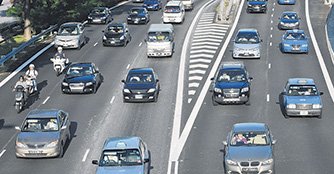Public transport ridership increases as car numbers fall
28 Feb 2015|1,859 views
Public transport ridership grew last year by 4.6 percent to hit a record 6.65 million trips per day as the population grew and the number of cars shrank, reported The Straits Times. It also came amid efforts by the Government to steer people towards buses and trains.

Responding to the twin developments, Government Parliamentary Committee for Transport chairman Cedric Foo said, "This is good news. We are headed in the right direction. Higher public transport ridership and lower number of cars both augur well for a sustainable transport profile in our small city-state. We must remain focused to improve commuter experience on public transport and to keep fares affordable."
Others wondered if the trend is the result of 'push' or 'pull' factors.
Mr. Vignesh Naidu Louis, a research associate at the Lee Kuan Yew School of Public Policy, said, "The increase in public transport ridership can be seen as a testament to the Government's commitment to ensuring an improvement in service quality. But I would be cautious with overemphasising that view as we must also account for the increasing cost of cars. Last year, COE (certificate of entitlement) prices were high and the Government introduced a revised tax rate for cars."
He said the impact of these policies must not be overlooked while assessing the rise in ridership. To him, the question was: Were people taking public transport because it had improved or was it because they had no choice?
Over the last few years, new MRT lines have opened, train frequencies have risen, and 550 additional buses under the tax-funded Bus Service Enhancement Programme were injected into the fleet as of last year. The introduction of free travel during off-peak hours, cheaper unlimited concession cards, and the launch of smartphone bus arrival information are among the other 'pull' factors.
For some commuters, however, turning to public transport has not been by choice, given that COE premiums hovered between $60,000 and $78,000 for small cars last year owing to a tight COE supply.
Public transport ridership grew last year by 4.6 percent to hit a record 6.65 million trips per day as the population grew and the number of cars shrank, reported The Straits Times. It also came amid efforts by the Government to steer people towards buses and trains.
The Land Transport Authority, in response to press queries, said MRT patronage grew the most, with average daily ridership rising by 5.3 percent to 2.76 million. Bus ridership followed with a 4.2 percent growth to 3.75 million. LRT numbers climbed by 3.8 percent to 137,000. Meanwhile, taxi ridership also hit a record of 1.02 million last year, up 5.5 percent from 2013.
Responding to the twin developments, Government Parliamentary Committee for Transport chairman Cedric Foo said, "This is good news. We are headed in the right direction. Higher public transport ridership and lower number of cars both augur well for a sustainable transport profile in our small city-state. We must remain focused to improve commuter experience on public transport and to keep fares affordable."
Others wondered if the trend is the result of 'push' or 'pull' factors.
Mr. Vignesh Naidu Louis, a research associate at the Lee Kuan Yew School of Public Policy, said, "The increase in public transport ridership can be seen as a testament to the Government's commitment to ensuring an improvement in service quality. But I would be cautious with overemphasising that view as we must also account for the increasing cost of cars. Last year, COE (certificate of entitlement) prices were high and the Government introduced a revised tax rate for cars."
He said the impact of these policies must not be overlooked while assessing the rise in ridership. To him, the question was: Were people taking public transport because it had improved or was it because they had no choice?
Over the last few years, new MRT lines have opened, train frequencies have risen, and 550 additional buses under the tax-funded Bus Service Enhancement Programme were injected into the fleet as of last year. The introduction of free travel during off-peak hours, cheaper unlimited concession cards, and the launch of smartphone bus arrival information are among the other 'pull' factors.
For some commuters, however, turning to public transport has not been by choice, given that COE premiums hovered between $60,000 and $78,000 for small cars last year owing to a tight COE supply.
Latest COE Prices
November 2025 | 1st BIDDING
NEXT TENDER: 19 Nov 2025
CAT A$110,002
CAT B$115,001
CAT C$76,000
CAT E$121,010
View Full Results Thank You For Your Subscription.


















